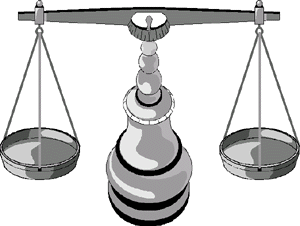Libra / The Scales
Tishrei 5757 / September 14 - October 13 , 1996

THIS MONTH'S SIGN
LIBRA / THE SCALES
The seventh is always holy. The seventh day is Shabbat, the seventh year is Shemitta, the Sabbatical Year. So too, the seventh month - Tishrei - is sanctified with more commands and festivals than any other month.
The sign of the month of Tishrei - Libra - is called in Hebrew
"Moznaim" which literally means "balances".
It's not difficult to see the connection between the symbol of
the balances and the month of Tishrei, for the first day of Tishrei
is Rosh Hashana - a day when the future of the world and all its
inhabitants literally hangs in the balance. The Rambam (Maimonides)
writes that a person should see himself, and the whole world,
as being on a knife edge, precisely and exquisitely balanced -half
meritorious and half culpable. If he does one sin, he tips the
balance of his own life and that of the whole world to the negative
side. However, with just one mitzvah, he can alter the balance
of his life and that of the whole world to the side of blessing
and life!
A 49 HOUR FAST!
Can you imagine what it must be like for Yom Kippur, the Day of Atonement, to last two days? For most of us 25 hours of fasting is quite enough. But during the Second World War, there were people who fasted for 49 hours - two days of Yom Kippur!When the Germans invaded Eastern Europe during the Second World War, the Mir Yeshiva made a miraculous escape across Europe and Asia to Kobe in Japan. However, when the Yamim Noraim (Days of Awe) approached, they were faced with a dilemma...
Up till the time of Hillel II, the date of the festivals, Pesach, Shavuot, Succot and Rosh Hashana were established via testimony based on the sighting of the new moon. The new month was declared in Jerusalem, and it would take many days for the news to reach the furthest outposts of Jewish settlement. Those outlying communities would observe two days of Pesach and Succot etc., and thus they would be sure of observing the festival on the correct day, no matter which day had been sanctified in Jerusalem as the new moon.
Until the era of the two great Talmudic sages Abaye and Rava, the months were still established by sighting. However, from their time onward, the date of the New Moon was established by calculations alone. These computations were given to Moses at Sinai, and provided for the fixing of the beginning of each month throughout the possible span of world history. Thus all the lengths of all future months in exile were now fixed.
So why is then that if you're in New York or London or Paris, you're still keeping two days of Yom Tov? If the calendar is fixed and we know exactly which day is Yom Tov and which isn't, why can't we all keep just one day?
 The answer is that our Sages made a law that we should continue
to observe the two days of Yom Tov as was the custom of our forefathers.
The answer is that our Sages made a law that we should continue
to observe the two days of Yom Tov as was the custom of our forefathers.
However, when our Sages mandated the continued observance of the two-day Yom Tov in the Diaspora as a continuation of the traditions of our forebears, they deliberately omitted a two-day Yom Kippur because it would be dangerous for some people to fast for such a long period.
However, the Mir Yeshiva in Kobe was faced with a different situation:
The omission of the Sages' decree to fast two days of Yom Kippur
was because we are certain on which day Yom Kippur occurs. However,
Japan is close to the International Date Line, (a longitudinal
line which lies 180° from Greenwich) and thus there was a
real doubt as to which day it was. For this reason, there were
those of the Mir Yeshiva who felt compelled to fast for two days.
And even others who were less strong, while they could not observe
the fast itself, commemorated all the other aspects of this holiest
day(s) of the year.
ANY OLD RUBBISH
If you think about it, the succah is a peculiar thing. We take great pains to deck out the succah so that it becomes our home away from home. We take into it our finest tableware and furnishings. We bedeck it like a princess with all manner of jewelry and decoration. And yet look up at the roof and what do you see? Rubbish. Dead palm fronds. "The chaff of the vineyard and the granary."It's difficult for us to visualize spiritual realities. We know that on Yom Kippur, if we merit it, all our sins have been forgiven. We emerge from shul as white as snow (and not from lack of food!)
In the four days between Yom Kippur and Succot, we rush around building our succot and getting our arba minim (four species). Our involvement in these activities guards us from sin. We know that Hashem has forgiven us, that the slate has been wiped clean...but where are all our mitzvot?
Our negative actions have been erased, but that just leaves us with a blank white sheet of paper. Where are all the mitzvot that should have been written on our report cards?
When a person does teshuva, when he returns to Hashem out of love, not only are his sins forgiven, but they are turned into mitzvot!
This is a very difficult concept for us to grasp, and maybe even as we sit in our succot, we may feel a twinge of sadness. Where are all my mitzvot?
It is at that moment we can look up and see a perfect visual-aid representation of sins being turned into mitzvot. The schach - the rubbish which is the ceiling of our succah - is the succah's essential part. Waste and rubbish has been turned into a mitzvah of incomparable spiritual beauty, outshining by far the brightest decoration and adornment. Now we can understand. Through teshuva that comes from love, we have turned our 'rubbish', our sins, into mitzvot.
VIEW
FROM THE
BOOTH
looking upward
The sky,
wheeling above my head
Stars,
winking through fronds of palm
The wind
rustling the night-time silence.
Tomorrow - with the dawn
Tomorrow - they will be together
Tomorrow.
The four corners of the world
will be One.
Lulav. Etrog. Hadass. Arava.
SOURCES :
- This Month's Sign - Aruch Hashulchan; Rambam - Hilchot Teshuva
- A 49 Hour Fast! - Rambam, Hilchot Yom Tov, ch. 1; Hilchot Kiddush Hachodesh, ch. 5; "Escape to Shanghai"; Rabbi Mordechai Becher
- Any Old Rubbish? - Rabbi Yissochar Dov Turnheim
SEASONS OF THE MOON is written by Rabbi Yaakov Asher Sinclair and edited by Rabbi Moshe Newman.
Designed and Produced by the Office of Communications - Rabbi Eliezer Shapiro, Director
Production Design: Lev Seltzer
HTML Design: Michael Treblow
© 1996 Ohr Somayach International - All rights reserved. This publication may be distributed to another person intact without prior permission. We also encourage you to include this material in other publications, such as synagogue newsletters. However, we ask that you contact us beforehand for permission, and then send us a sample issue.
This publication is available via E-Mail
Ohr Somayach Institutions is an international network of Yeshivot and outreach centers, with branches in North America, Europe, South Africa and South America. The Central Campus in Jerusalem provides a full range of educational services for over 550 full-time students.
The Jewish Learning Exchange (JLE) of Ohr Somayach offers summer and winter programs in Israel that attract hundreds of university students from around the world for 3 to 8 weeks of study and touring.
Ohr Somayach's Web site is hosted by DreamHost
 Copyright © 1996 Ohr Somayach International.
Send comments to: ohr@ohr.edu
Copyright © 1996 Ohr Somayach International.
Send comments to: ohr@ohr.edu






